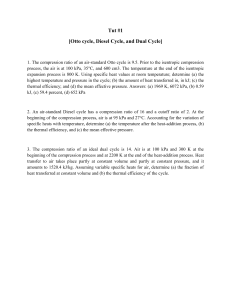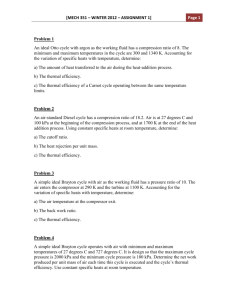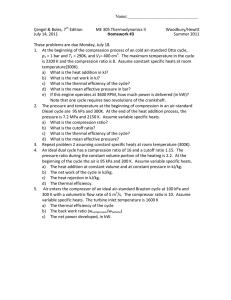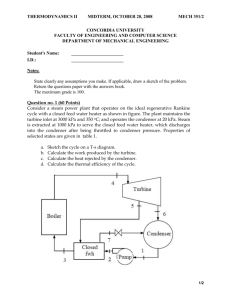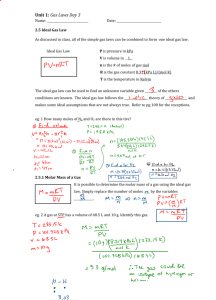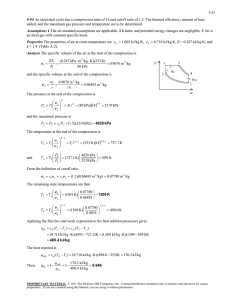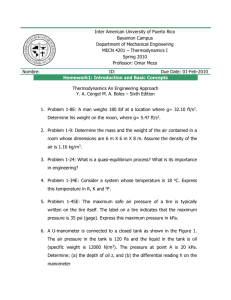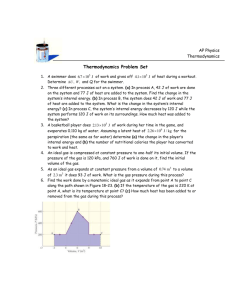Phys 340 - People.vcu.edu
advertisement
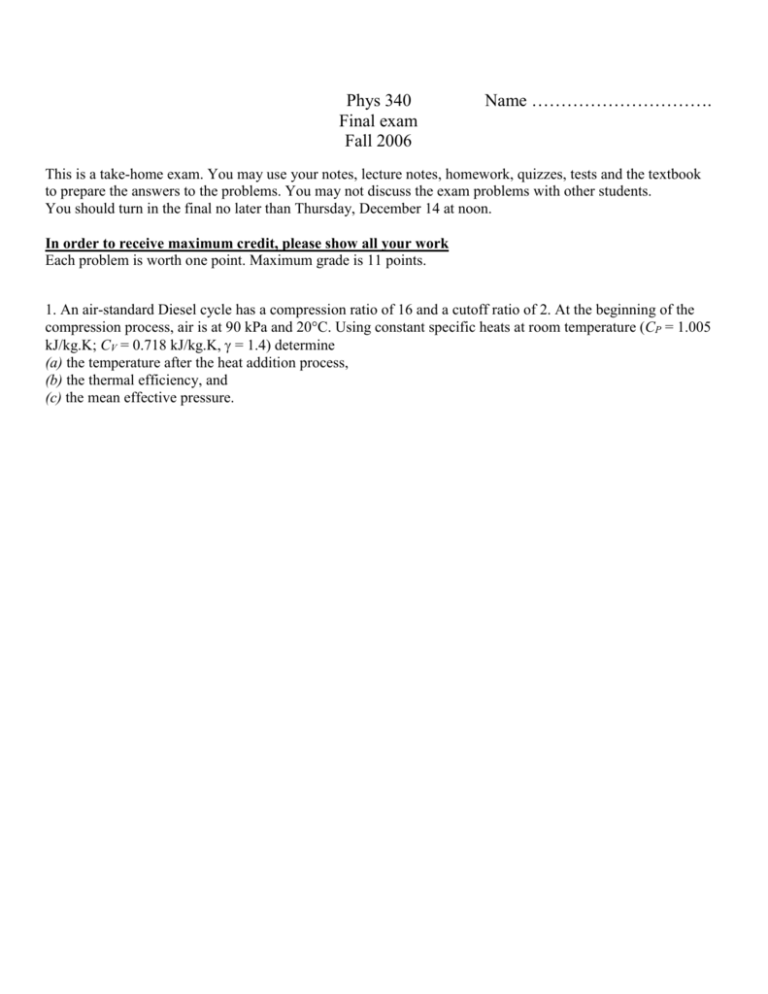
Phys 340 Final exam Fall 2006 Name …………………………. This is a take-home exam. You may use your notes, lecture notes, homework, quizzes, tests and the textbook to prepare the answers to the problems. You may not discuss the exam problems with other students. You should turn in the final no later than Thursday, December 14 at noon. In order to receive maximum credit, please show all your work Each problem is worth one point. Maximum grade is 11 points. 1. An air-standard Diesel cycle has a compression ratio of 16 and a cutoff ratio of 2. At the beginning of the compression process, air is at 90 kPa and 20°C. Using constant specific heats at room temperature (CP = 1.005 kJ/kg.K; CV = 0.718 kJ/kg.K, = 1.4) determine (a) the temperature after the heat addition process, (b) the thermal efficiency, and (c) the mean effective pressure. 2. Calculate the free-energy change (G ) at 737 K for the formation of ammonia from gaseous nitrogen and hydrogen (N2(g) + 3H2(g) = 2NH3(g)), given that, for the reaction (H)298K = -91 629.60 J (G)298K = -32 718.88 J (Cp )N2 = 6.50 + 0.0010T J/ K.mol (Cp )H2 = 6.50 + 0.0009T J/K.mol (Cp )NH3 = 8.04 + 0.0007T + 0.0000051T2 J/K.mol. 3. Show that for an isobaric process 4. A sample of an ideal gas is taken through the cyclic process abca shown in figure; at point a, T = 300 K. (a) How many moles of gas are in the sample? What are (b) the temperature of the gas at point b, (c) the temperature of the gas at point c, and (d) the net heat added to the gas during the cycle? 5. One mole of an ideal monatomic gas traverses the cycle shown in figure. Process 1 → 2 takes place at constant volume, process 2 → 3 is adiabatic, and process 3 → 1 takes place at constant pressure. (a) Compute the heat Q, the change in internal energy U and the work done W, for each of the three processes and for the cycle as a whole. (b) If the initial pressure at point 1 is 1.00 atm, find the pressure and the volume at points 2 and 3. Use 1.00 atm = 1.013 x 105 Pa and R = 8.314 J/mol.K. 6. An insulated rigid tank is divided into two equal parts by a partition. Initially, one part contains 3 kg of an ideal gas at 800 kPa and 50oC, and the other part is evacuated. The partition is now removed, and the gas expands into the entire tank. Determine the final temperature and pressure in the tank. 7. A piston-cylinder device contains helium gas initially at 150 kPa, 20°C, and 0.5 m3. The helium is now compressed in a polytropic process (PVn = constant) to 400 kPa and 140°C. Determine the heat transfer for this process. 8. A Carnot refrigerator operates in a room in which the temperature is 25°C. The refrigerator consumes 500 W of power when operating and had a COP of 4.5. Determine (a) the rate of heat removal from the refrigerated space and b) the temperature of the refrigerated space. 9. An air-standard cycle is executed in a closed system and is composed of the following four processes: 1-2 Isentropic compression from 100 kPa and 27oC to 800 kPa 2-3 V = constant heat addition to 1800 K 3-4 Isentropic expansion to 100 kPa 4-1 P = constant heat rejection to initial state (a) Show the cycle on P-V diagram . (b) Calculate the net work output per unit mass. (c) Determine the thermal efficiency. 10. Air is compressed by a 8-kW compressor from P1 to P2. The air temperature is maintained constant at 25°C during this process as a result of heat transfer to the surrounding medium at 10°C. Determine the rate of entropy change of the air and the rate of total entropy generation. State the assumptions made in solving this problem. Does this process satisfy the second law of thermodynamics? 11. An ideal diesel engine has a compression ratio of 20 and uses air as the working fluid. The state of air at the beginning of the compression process is 95 kPa and 20°C. If the maximum temperature in the cycle is not to exceed 2200 K, determine (a) the thermal efficiency (b) the mean effective pressure. Assume constant specific heats for air at room temperature.
